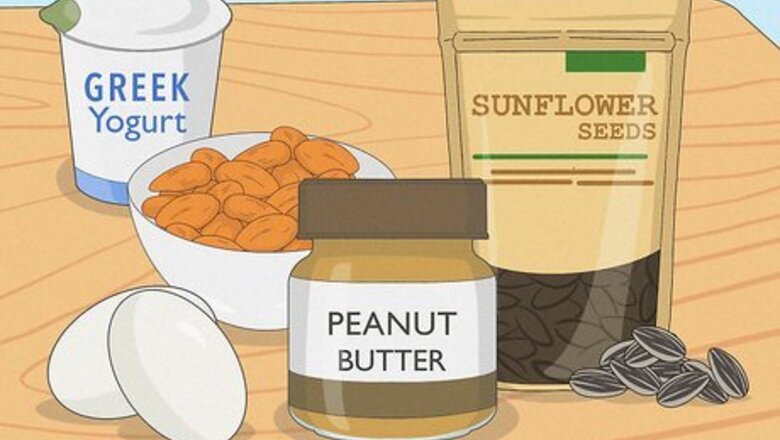
views
- Include high-quality sources of protein in each of your meals, like lean meats, fish, eggs, quinoa, tofu, cottage cheese, or low-fat milk.
- To realistically consume 120 g of protein a day, try to split your goal into 5 meals (24 g each), or 3 meals (24 g each) with 4 smaller snacks (12 g each).
- Snack on foods like dried meats, nuts, seeds, yogurt, string cheese, and peanut butter to help you feel energized and reach 120 g of protein daily.
Incorporating Protein into Meals

Add high-quality sources of protein to your meals. Some great, nourishing sources of protein can include lean meats like chicken or fish, eggs, quinoa, beans, and nuts and seeds. Try to include these high-quality protein sources into every meal and snack: Animal-derived proteins: 3 oz chicken breast (32 g of protein), 100 g ground turkey (17 g), 100 g ground pork (18 g), 100 g of fish (16 g), 171 g of drained canned tuna (49.8 g), 100 g shrimp (25 g), beef jerky (6 g each), whole eggs (6 g each), 247 g of low-fat milk (8.4 g), Greek yogurt (16 g per 156 g container), and 220 g of low-fat cottage cheese (24 g). Plant-based proteins: 100 g of nuts like almonds (21 g of protein) or cashews (17 g), 100 g of chia seeds (16.5 g), 100 g of pumpkin seeds (30 g), 100 g of sunflower seeds (20.8 g), 100 g of lentils (24.6 g), 100 g of black beans (6 g), 100 g canned chickpeas (7 g), 100 g of tofu (18.8 g), 100 g of peanut butter (24 g), and 100 g of oats (17 g).
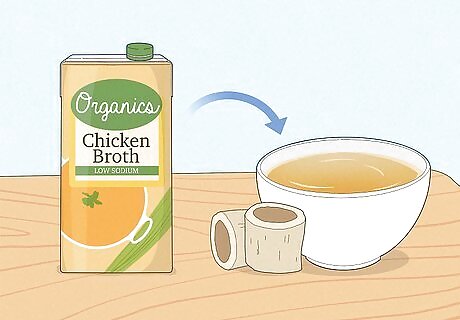
Swap out a few lower protein foods for higher protein foods. Eating more protein doesn’t mean you have to change your entire diet. Instead, it may be easier to swap out a few ingredients for foods with a little extra protein. Here are a few easy swaps you can make to include a few extra grams of protein into your diet: Regular pasta (6 g of protein per 100 g) for bean and lentil-based pasta (14 g of protein per 100 g) Regular yogurt (6 g of protein per 6 oz) for Greek yogurt (17 g of protein per 6 oz) White rice (3.5 g of protein per 250 g) for quinoa (8.1 g of protein per 250 g) Chicken broth (1 g of protein per 230 g) for bone broth (9 g of protein per 230 g)
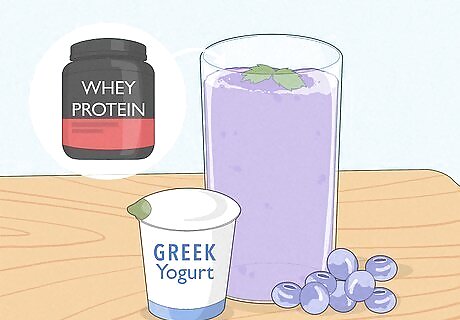
Consider supplementing your protein intake with powders and bars. Consuming whole foods is generally better for meeting all of your daily nutritional needs, and most people can get enough protein from their diet alone. Instead of using protein supplements like bars or powders as meals, try to use them to get in those last few grams of protein during snack time. Mix protein powders into water or low-fat milk as a shake or add them to pancakes, oatmeal, fruit smoothies, or plain yogurt. Filling your diet with a variety of protein sources, vegetables, fruits, and grains can help you avoid nutrient deficiencies. Try to look for powders and bars with at least 12 g of protein per serving, 200 or fewer calories, 2 grams or less of saturated fat, 5 grams or less of sugar, and no trans fat (partially hydrogenated oils). Some studies recommend that protein supplements should only be used to improve professional athletic performance and recovery when you can’t get all the benefits of protein by just eating regular foods.
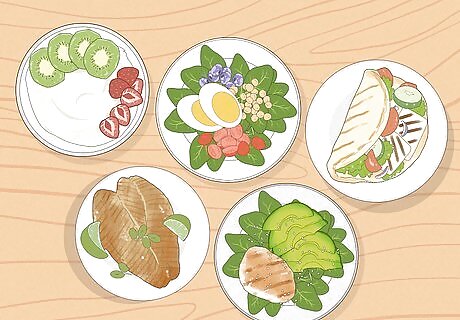
Split your protein intake goal into at least 5 meals. Most meals that are considered to be “high-protein” have around 20 to 25 grams on average, which means you’d likely have to split a goal of 120 g of protein into at least 5 meals throughout the day. For example, to eat a total of 120 g of protein a day you may split your protein intake into 4 larger meals with 24 g of protein each and 2 snacks with 12 g of protein each. Divide how much protein you’d like to consume each day by the number of meals, including snacks, to ensure that each meal has about 20-25 g of protein. If your body takes in more than 40 g of protein in a short period of time, the excess protein may go into fat storage or become waste instead.
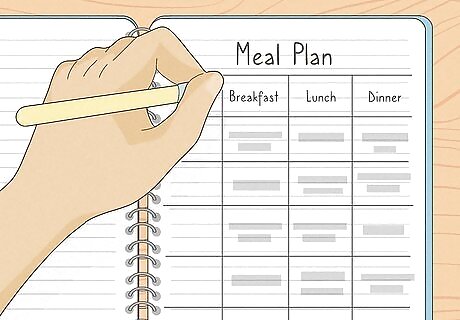
Plan meals in advance to prepare and eat at home. At the beginning of each week, write down each meal you want to make and buy protein-rich ingredients to pack in 20-25 g per meal. Meal planning can help you make healthy nutritious meals and meet your 120 g protein goal consistently each week. Consider eating intuitively—try eating an amount of protein, and if it feels good, keep at it. If it doesn’t, consider lowering or increasing your protein intake. Keep your caloric goal in mind when planning meals if your goal is to lose weight—each gram of protein is about 4 calories, which means eating 120 g of protein may add 480 calories a day to your diet.

Use an app to track your protein and other macronutrient intake. Counting your macros can help you make smart, healthy food choices. Try logging the meals you eat on an app like MyFitnessPal or Nutritionix to keep track of your protein, carbohydrate, and fat consumption. If your goal is to lose weight, consider tracking your overall calorie intake alongside your protein intake to help you meet both goals.
Sample Meal Plans

Breakfast Aim to eat around 24 g of protein for breakfast. Eggs, sausage, bacon, yogurt, cottage cheese, oats, and peanut butter are all examples of some high-protein breakfast foods you can include in your meal to help you reach 24 g. Animal-derived breakfasts: Make scrambled eggs with tomatoes, eggs, basil, and baby spinach for a healthy and delicious start to your day. Swap out the yogurt for cottage cheese to get this meal to a total of 25 g of protein. Vegetarian breakfast: Fix up a quick chocolate-peanut butter protein shake with vanilla soymilk, frozen bananas, Greek yogurt, cocoa powder, and peanut butter for a total of 26 g of protein. Vegan breakfast: Enjoy two pieces of toast with peanut butter and a cup of soy milk for a breakfast with about 22 g of protein. Add about 1 oz of nuts or seeds on the side for an extra 6 g.
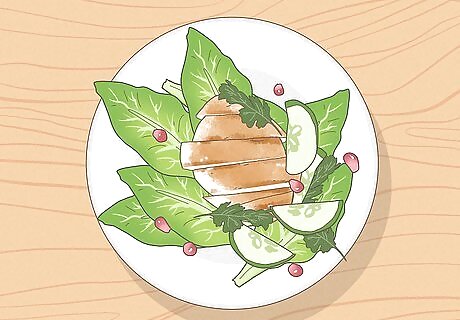
Lunch Try to include at least 24 g of protein in your lunchtime meals. Lean meats, cottage cheese, beans, lentils, and tofu can make great additions to the meals in your lunch rotation to help you reach 24 g. Animal-derived lunch: Try an easy chicken satay salad for an easy midweek meal with a ton of extra protein. All you need is chicken, crunchy peanut butter, sweet chili sauce, lettuce hearts, cucumber, a banana shallot, pomegranate seeds, and a whole lot of delicious spices to get around 38 g. Vegetarian lunch: Enjoy a healthy veggie carbonara with courgettes (zucchinis), spaghetti noodles, egg yolks, vegetarian parmesan cheese, chestnut mushrooms, garlic, and lemon to get 29 g of protein. Vegan lunch: Try a quinoa bowl with black beans, hummus, lime juice, avocado, pico de gallo, and fresh cilantro for an easy lunch. Add in a handful of cashews for a total of 25 g of protein.
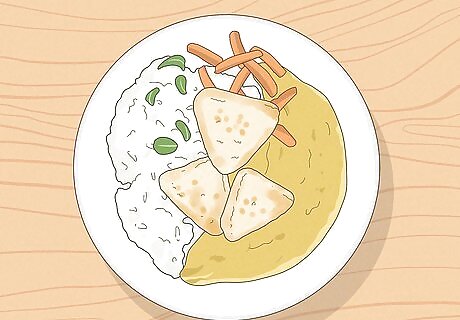
Dinner Aim to get 24 g of protein in your dinner meals. Great sources of protein to add to help you reach 24 g might include lean meats and poultry, fish, kidney beans, and cheese. Animal-derived dinner: For an easy one-pot dinner, try making a southwestern quinoa bowl with shrimp, black beans, corn, vegetable broth, cilantro, and lime for a total of 38.5 g of protein. Vegetarian dinner: Cook three-bean chili with bell peppers, onion, crushed tomatoes, diced tomatoes, kidney beans, black beans, pinto beans, and hot sauce to taste for about 21.5 g of protein. Try adding 1 oz of cashews or 1 oz of tofu to help you reach your 24 g goal. Vegan dinner: Make a fresh katsu curry with rice, cucumber, carrot, onion, garlic, ginger, coconut milk, maple syrup, and tofu coated in cornflour and dried breadcrumbs for 37 g of protein.
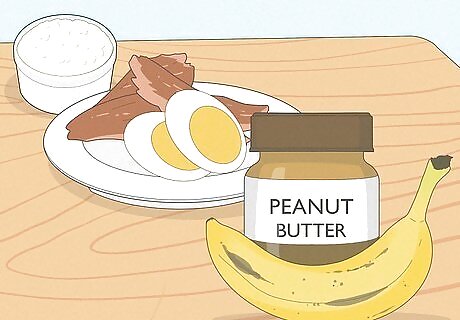
Snacks Try to eat at least 4 snacks throughout the day, with each snack averaging about 12 g of protein each. Dried meats, cheese, yogurt, nuts, and peanut butter are just a few examples of quick easy snack ingredients you can add to help you reach your 12 g goal. You can also eat a can of sardines (with 22.6 g of protein) for a quick boost. Animal-derived snacks: Eat 100 g of cottage cheese (12 g of protein), 1 oz turkey jerky (11 g), 2 hardboiled eggs (12 g), or 50 g of peanut butter (12 g) with a banana for an energizing protein snack. Vegetarian snacks: Try 2 pieces of light string cheese (14 g), a single-serve oatmeal cup (12 g), or a whole-grain protein bar (around 15 g). Vegan snacks: Snack on 100 g of edamame (12 g), 253 g of roasted chickpeas (18 g), 200 g of hummus (15.5 g) and carrot sticks, or 100 g of a vegan trail mix (13.8 g).
How much protein do you need?
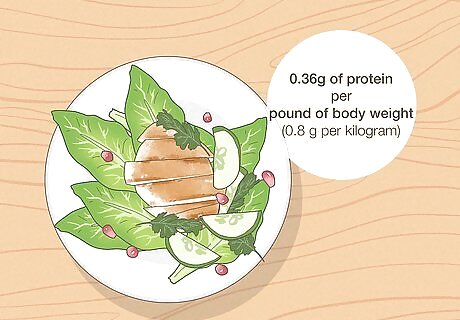
Try to consume 0.36 grams of protein per pound of body weight. Aim to eat about 0.36 g of protein per pound (0.8 g per kilogram) of body weight to meet your basic nutritional requirements. Depending on your age, weight, sex, and activity level, your protein needs may be higher. For example, people over age 65 should aim for 0.45 to 0.55 g of protein per pound (0.99 to 1.2 g per kilogram) of body fat daily. If you’re pregnant, your recommended intake is 60 g of protein per day. Depending on your needs, anywhere from 10% to 35% of your daily calories should come from protein. Depending on your needs and activity level, 120 g of protein a day might be too much for you. Try using an online calculator to determine how much protein you should have each day.
Why is protein important?
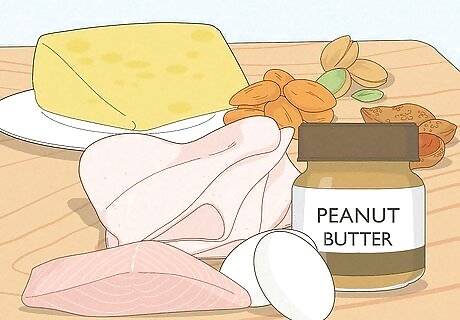
Meet your daily protein requirements to repair and grow cells. Proteins are made up of building blocks called amino acids that your body uses to make new proteins like muscle, bone, enzymes, and hormones. There are 9 amino acids that your body can’t make alone that need to be included in your diet so your body can function properly. Protein is also important for the growth and development of children, teenagers, and people who are pregnant. If you’re not eating enough protein, you could be at more risk for injury, weight gain, dry nails, or split ends, and you may feel hungry more frequently.



















Comments
0 comment